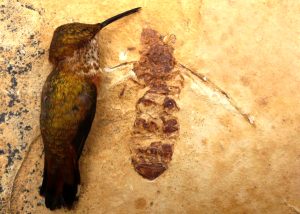Podcast: Play in new window | Download (Duration: 6:48 — 7.7MB)
Thanks to Richard from NC for suggesting Titanomyrma!
Further reading:
‘Giant’ ant fossil raises questions about ancient Arctic migrations
A fossilized queen Titanomyrma ant with a rufous hummingbird (stuffed) for scale:

Show transcript:
Welcome to Strange Animals Podcast. I’m your host, Kate Shaw.
This week we have a suggestion from Richard from North Carolina, who sent me an article about an extinct giant ant called Titanomyrma. This episode is short, but I think you’ll find it interesting.
We’ve talked about ants in previous episodes, most recently episode 185. Most ant colonies consist of a single queen ant who lays all the eggs for her colony, seasonally hatched males with wings who fly off as soon as they’re grown, and worker ants. The worker ants are all female but don’t lay eggs. Army ants have another caste, the soldier ant, which are much larger than the worker ants and have big heads and strong, sharp mandibles. In many species of ant, the worker ants are further divided into castes that are specialized for specific tasks.
The biggest species of ant alive today is probably the giant Amazonian ant. The workers can grow over 1.2 inches long, or more than 3 cm, which is huge for an ant. It lives in South America in small colonies, usually containing less than 100 workers, and unlike most ants it doesn’t have a queen. Instead, one of the workers mates with a male and lays eggs for the colony. The giant Amazonian ant can sting and its sting contains venom that causes intense pain for up to two days. Fortunately, you will probably never encounter these giant ants, and even if you do they’re not very aggressive.
Another contender for the biggest species of ant alive today is the Dorylus genus of army ants, also called driver ants, which we talked about in episode 185. It lives in Africa in colonies that have millions of members, and the queen is the largest ant known. A queen army ant can measure 2.4 inches long, or 63 millimeters, but worker ants are much smaller.
Around 50 million years ago, giant ants related to modern driver ants lived in both Europe and North America. The genus is Titanomyrma and three species are known so far, found in Germany, England, Canada, and the American states of Tennessee and Wyoming.
The Wyoming ant fossil was discovered years ago and donated to the Denver Museum of Nature and Science, where it was stored in a drawer and forgotten about. In 2011 a curator found it and showed it to a paleoentomologist named Bruce Archibald. Dr. Archibald recognized it immediately as a fossilized queen ant even though it was the size of a hummingbird. He also realized it was very similar to a type of giant ant that once lived in Germany.
The German discovery was the first Titanomyrma species discovered, and it’s also the biggest known so far. The queen Titanomyrma gigantea grew up to 2.8 inches long, or 7 centimeters. Males grew up to 1.2 inches long, or 3 cm. The fossilized queen ants found have wings, with a wingspan of over 6 inches, or 16 cm. The other two known species are generally smaller, although still pretty darn big for ants.While they’re not that much bigger than the living Dorylus queens, most of the size of a queen Dorylus ant comes from her enlarged abdomen. Titanomyrma ants were just plain big all over.
Titanomyrma didn’t have a stinger, so it’s possible it used its mandibles to inflict bites, the way modern army ants do. It might also have sprayed formic acid at potential predators, as some ants do today.
The biggest ants alive today all live in tropical areas, so researchers thought Titanomyrma probably did too. During the Eocene, the world was overall quite warm and parts of Europe were tropical. The northern hemisphere supercontinent Laurasia was in the process of breaking up, but Europe and North America were still connected by the Arctic. Even though the Arctic was a lot warmer 50 million years ago than it is now, it was still too cold for a tropical ant. If Titanomyrma couldn’t survive in cold weather, how did it spread from one continent to another when it had to go through the Arctic?
There were warming periods during the Eocene that lasted a few hundred thousand years at a time, so researchers thought the ants probably migrated through the Arctic while it was warmer than usual. Then, in early 2023, a fossilized Titanomyrma queen ant was discovered in Canada. Because the rock it was preserved in has been distorted over the years, we can’t be certain how big the ant actually was. What we do know, though, is that the ant lived in a mountainous area that could get quite chilly, very different from the tropical climate scientists thought the giant ants needed.
As a result of the new finding, researchers are reconsidering whether the giant ants that lived 50 million years ago were really all that similar to modern giant ants. Just because the biggest ants alive today require tropical climates doesn’t mean that ancient giant ants did.
Hopefully more giant ant fossils will turn up soon, so we can learn more about where they lived, how they lived, and precisely how big they could get.
You can find Strange Animals Podcast at strangeanimalspodcast.blubrry.net. That’s blueberry without any E’s. If you have questions, comments, or suggestions for future episodes, email us at strangeanimalspodcast@gmail.com. If you like the podcast and want to help us out, leave us a rating and review on Apple Podcasts or Podchaser, or just tell a friend. We also have a Patreon at patreon.com/strangeanimalspodcast if you’d like to support us for as little as one dollar a month and get monthly bonus episodes.
Thanks for listening!